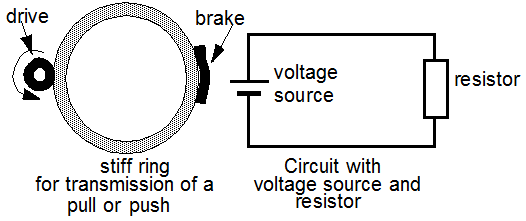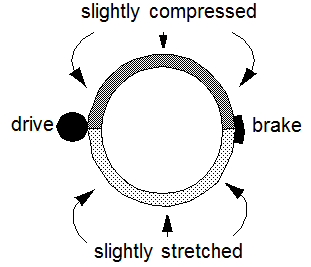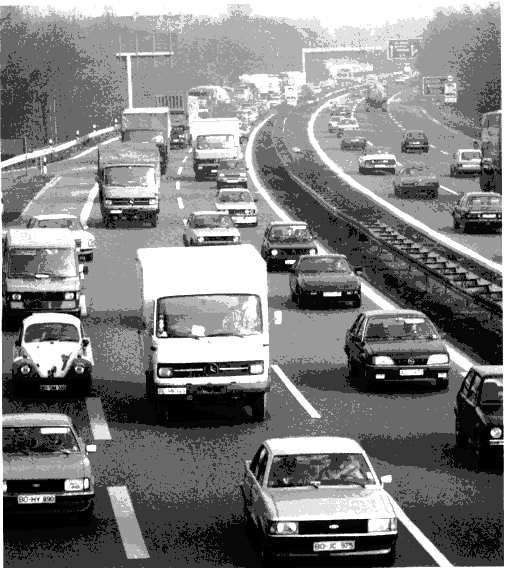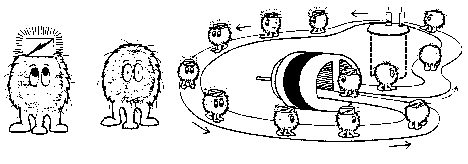back to Circuits (home page)
4. Models for the electric circuit
4.1. Comparison between a stiff ring and a circuit
To illustrate the processes within an electric circuit it is helpful to compare such a circuit with a stiff ring driven by a motor at one place and restricted in its motion by a brake at another place.

Fig. 8: Mechanical model for the electric circuit
The attribute "stiff" should not be understood in an absolute sense. Every real object shows some elastic behaviour under the impact of a force. It may be rather small, however, it will never be zero.

Fig. 8: Mechanical model for the electric circuit
4.2.Difference between feed and return line
Real objects are, as already mentioned, never stiff in an absolute sense, but will always show some elastic behaviour. This applies to liquids like water as well as for solids like for instance steel or rubber. Only the degree of elasticity is different.
If this elastic behaviour is taken into account for a stiff ring, which is used as device to transmit a force, it can be concluded that the two parts, the part before the brake under push and the part behind the brake under pull will deform differently.

Fig. 9: Elastic deformation of a stiff ring
The pushed part will become slightly compressed, the pulled part will become slightly stretched. This difference in deformation will be sustained by the motor and will produce the necessary force at the brake to keep the ring moving.
While passing the brake the material of the ring will expand from a compressed to a stretched state. This change in density is certainly rather small in comparison with the amount of circulating material, however, it always exists. To know about these deformations, however, will be helpful if not necessary to reach a deeper understanding of the process to transmit a force, especially in comparison with the functioning of an electric circuit.

Fig. 9: Elastic deformation of a stiff ring
4.3. Comparison between model and electric circuit
The similarities between the electric circuit and a stiff ring with a drive and a brake can be summarized as follows:
| Stiff ring | Electric circuit |
|---|---|
| The stiff ring serves to transmit a force | The electric circuit transmits a force |
| Matter moves in a circle. | Electrons move in a circle. |
| Matter is not consumed. | Electrons (electric current) are not consumed. |
| The stiff ring is pushed by the motor on one side and pulled on the other side. | The mobile or free electrons within a conductor can also be seen as an ensemble like a gas, a so-called "electron gas". This "electron gas" is pushed at one side by the force of the power source and pulled by the other side. |
| The stiff ring will be compresses or stretched by the motor i.e. its density will be changed. | The "electron gas" will be compressed and stretched respectively. As a result the density of the charges at the surface of the conductors just before and behind a resistor will be changed. |
| When passing through a braking area the driving force of the motor is transformed to a density change of the stiff ring, which on its part can be looked at as the local cause to overcome the braking action. | When an electric current is flowing through a resistor, the force of the power source is transformed to a difference in charge density before and behind the resistor. This change in charge density can be looked at as a local force which is necessary to keep the current flowing through the resistor. |
For an electric current only the density of charges on the surface of metallic conductors can change. The internal parts of conductors are always neutral.
In addition there is an obvious difference in respect to practicability. The stiff ring is rather inflexible with no application in technical areas. There are more flexible variants in form of a bicycle chain or a drive belt with wide spread use. These variants as model for the electric current, however, are of limited use, because the driving force in these systems can only apply a pull and no push. The analogy to the symmetry of the Coulomb force with attraction and repulsion is missing
4.4. Restricted models for the electric current
In comparison with the stiff ring, the bicycle chain or the drive belt other circular systems like a hot-water system, a conveyor belt or a blood circuit can be used as model for the electric circuit in a much more restricted manner.

Fig. 10: Circular systems, where energy-rich matter is transported
- only of restricted use as model for the electric current
These systems do not transmit a force but mainly energy-rich matter. The transmission of energy is therefore coupled to the motion of the transmitting medium. Within an electric circuit, however, the electrons are drifting with a rather low velocity while the action of the force is spread out with nearly the speed of light.

Fig. 10: Circular systems, where energy-rich matter is transported
- only of restricted use as model for the electric current
4.5. Problematic models for the electric circuit
In some textbooks systems are shown as model for the electric circuit, where the single components can be driven individually. Trucks on a highway running back and force between a loading and unloading station are such an example.

Fig. 11: Trucks running back and forth on a highway
a problematic model for an electric circuit
In contrast to such a system electrons do not have an own drive but are driven by an external power source. No electron can for instance stop or slow down if it encounters a resistor without influencing all other electrons in the same way.
However, if a traffic jam occurs on a highway, only the cars in front of this jam are affected. The cars behind the jam and those on the opposite lane continue to move unaffected.
The following example from an American textbook demonstrates that such reflections are not self-evident.

Fig. 12: Problematic model for the electric circuit
In this model it is again assumed that the electrons can move ahead by them selves while transporting energy from the battery to the motor.
Many questions remain open:
- Why will all electrons stop if a single electron will be stopped?
- What happens if a second motor is added behind the first one?
- Why can the effect of the battery spread out with higher speed than the speed of the electrons?
This model disregards that the interconnection between the mobile electrons is an essential property of the electric circuit, without which it would loose most of its unique properties as a system.

Fig. 11: Trucks running back and forth on a highway
a problematic model for an electric circuit

Fig. 12: Problematic model for the electric circuit
back to Circuits (home page)